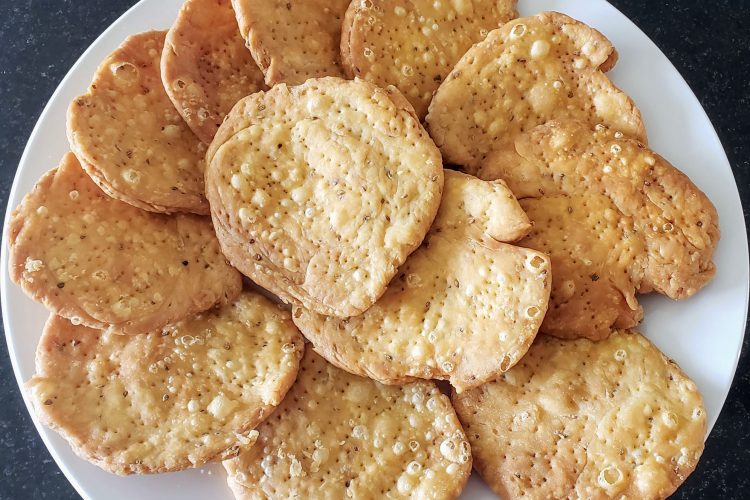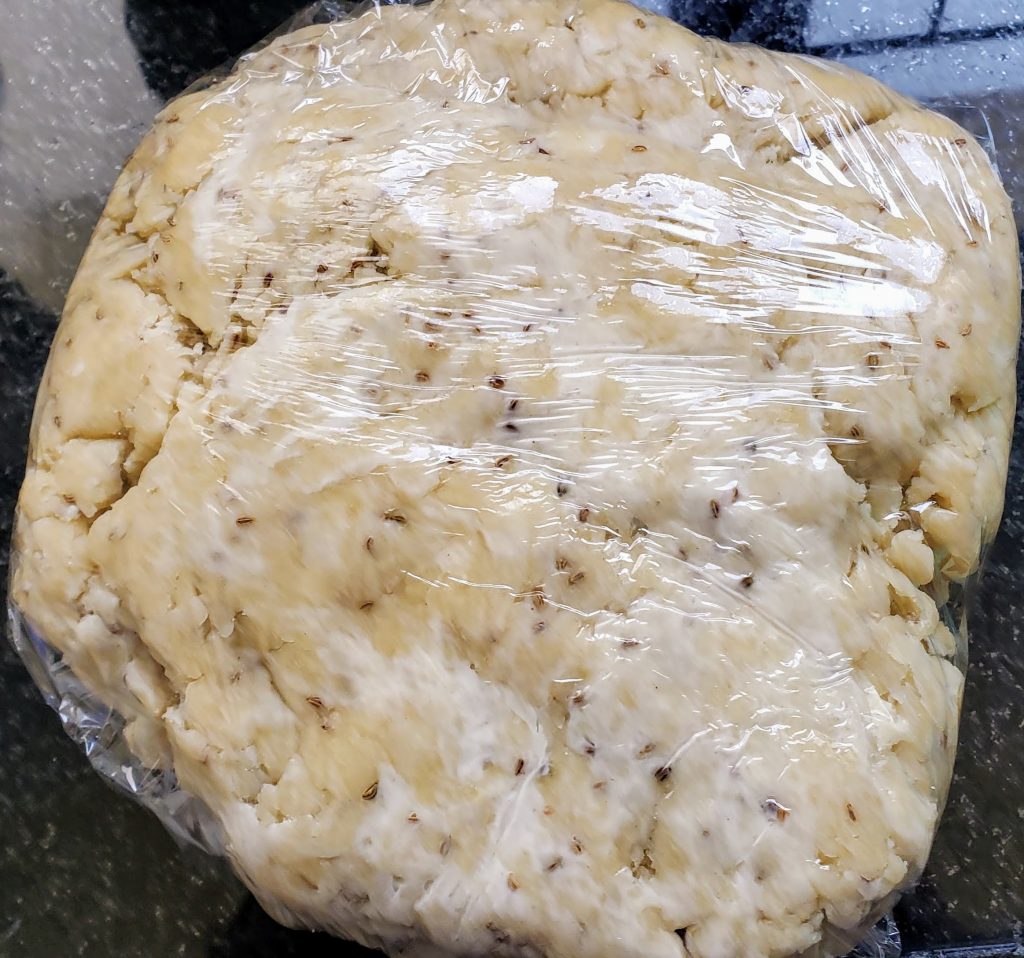If you have never had a Mathi, you don’t know what you are missing. This is top on my list of comfort foods. I’m still basking in the afterglow from having eaten three of them for breakfast with my cup of Masala Chai.
Mathi is a crisp, flaky pastry that is generally served during high tea. My mother made them as a snack for our family vacations when we traveled long distances by car. Mathis make a great appetizer when serving cocktails as they can be easily eaten with one hand while holding a drink in the other. My kids eat them as an after school snack. I like eating them for breakfast, with a side of Indian pickle and a hot cup of tea. Heaven!
The pastry dough is the same as Samosas (see blog for Samosa) and Kachoris. However, I like to flavor the Mathis with different herbs and spices for variety. Here are some tips for deep frying. I got some of these tips from the www.npr.org website “The Science Secrets To The Double Fry”.
To ensure the crispiness of deep-fried foods that are dense, you should fry them twice. The reason being, when you fry food, you are dehydrating it. However, when food is dense or thick, the water vapor trapped in the center of the food rises to the surface as it cools resulting in a soggy crust.
Let the fried food to cool slightly to allow the water to condense onto the outer surface before frying again. The second frying will drive off the surface water and crisp up the outside. The second frying requires less time. The resulting dish will have a lovely golden color and a crispy exterior.
Tips for Deep Frying:
- Use a wok or a deep straight-sided pot with a small diameter, i.e. a 5-quart cast iron pot is a good choice;
- Use an oil with a high smoking point like peanut oil, sunflower oil, canola oil;
- The level of the food should not be higher than the level of the oil;
- The level of the oil in the pan should be around 2 1/2-3 inches deep;
- Heat the oil gradually. Do not let it smoke;
- Set fried food directly on paper towels as this allows the surface oil on the food to be absorbed immediately;
- Use metal tongs or a slotted metal spoon to remove fried foods from the pan;
- The first fry at 350F is for cooking the food through. This will be a longer frying time. Frying time will vary depending on the thickness of the food. The food should be light in color after the first frying. You may need to reduce the heat after the first 5 minutes to prevent over-browning.
- Remove the food and place it on a paper towel-lined tray. The fat from fried food gets reabsorbed into the food within seconds of coming out of the frier. To avoid this, quickly mop up the surface of the food with paper towels after setting it down on the tray.
- The second frying is at 375F and for a shorter time. Once the food has had sufficient time to cook through and is light golden brown, remove it from the frying pan and set it on a paper towel-lined tray before serving.
Hands-on time: 30 minutes
Rest time: 30 minutes
Cook time: 15 minutes
Yield: 18-20 large Mathis
pastry dough
- 2 1/2 cups all-purpose flour
- *2-3 teaspoons ajwain (carom seeds) or 2-3 teaspoons jeera (cumin seeds) or 2-3 teaspoons sooki methi (dried fenugreek) or 2-3 teaspoons whole black peppercorns – You can add any combination of these seasonings, however, the total amount should not exceed 3 teaspoons.
- 1 teaspoon salt
- 1/4 cup plus 1 tablespoon vegetable oil
- 1/2 cup of ice water
INSTRUCTIONS
1. Measure the flour into a mixing bowl and add the salt and the carom (ajwain) seeds (or the seasoning(s) of your choice). Mix until the seeds are evenly distributed. Add the oil and mix using your hands.
2. The flour should start to clump together into the size of large peas. To verify you have enough oil, pick up a handful of flour and close your hand around it making a fist. When you open your hand, the flour should hold the shape of your fist without falling apart. If not, add another tablespoon or so of oil, mix well and repeat the fist test.
I use this technique when making pie crust and other types of pastry dough.
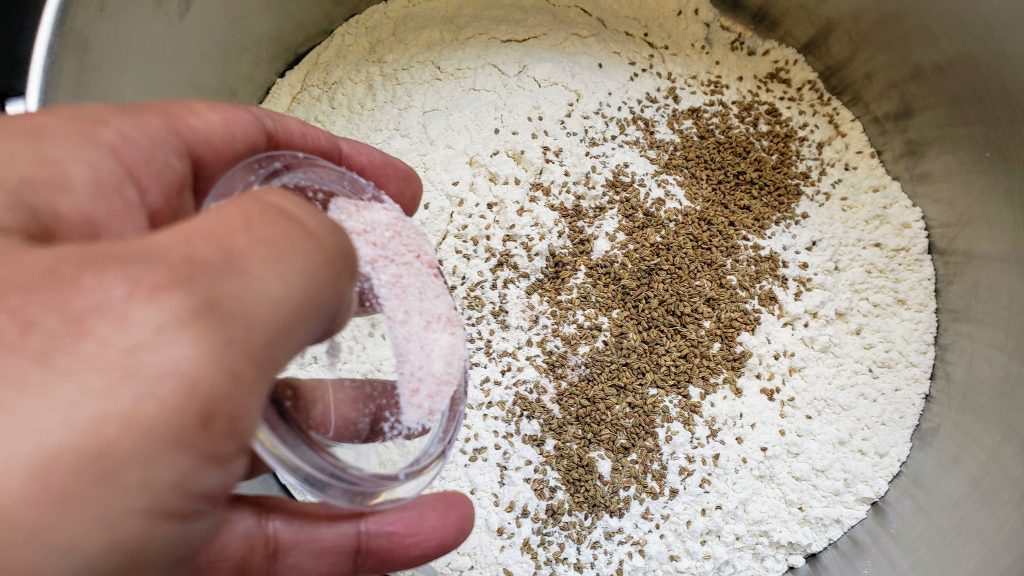
Adding salt and carom seeds 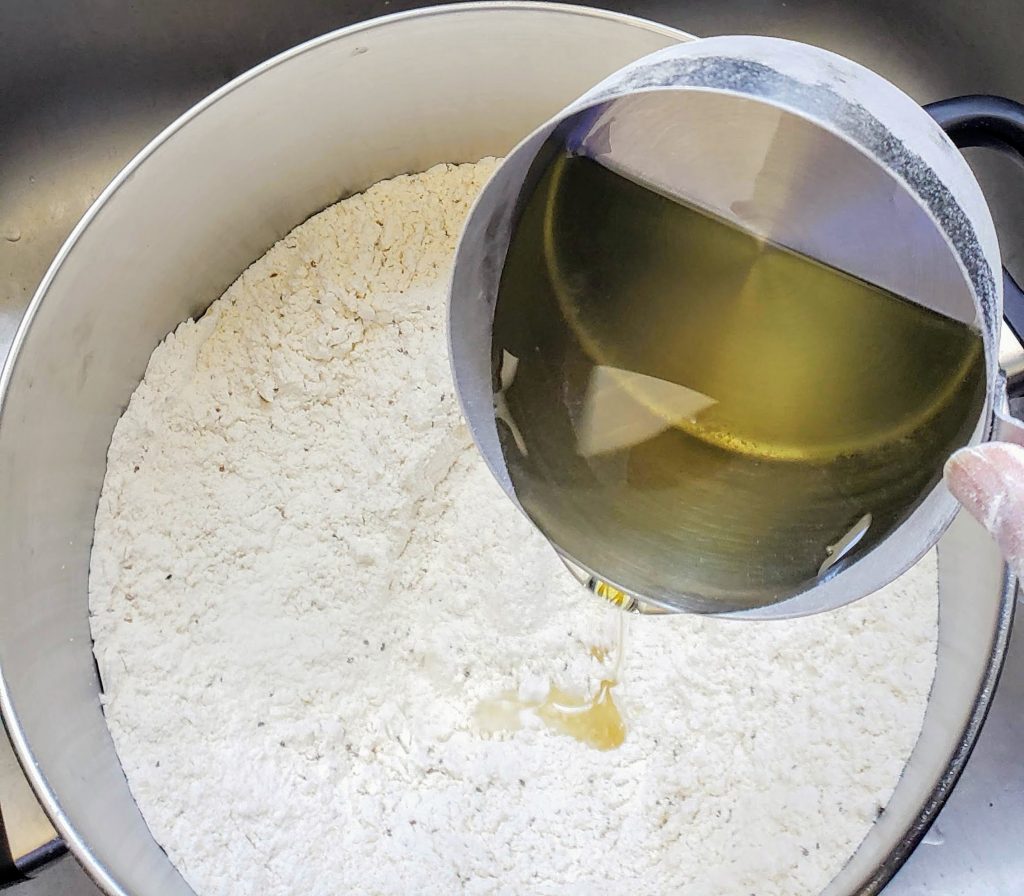
Adding canola oil 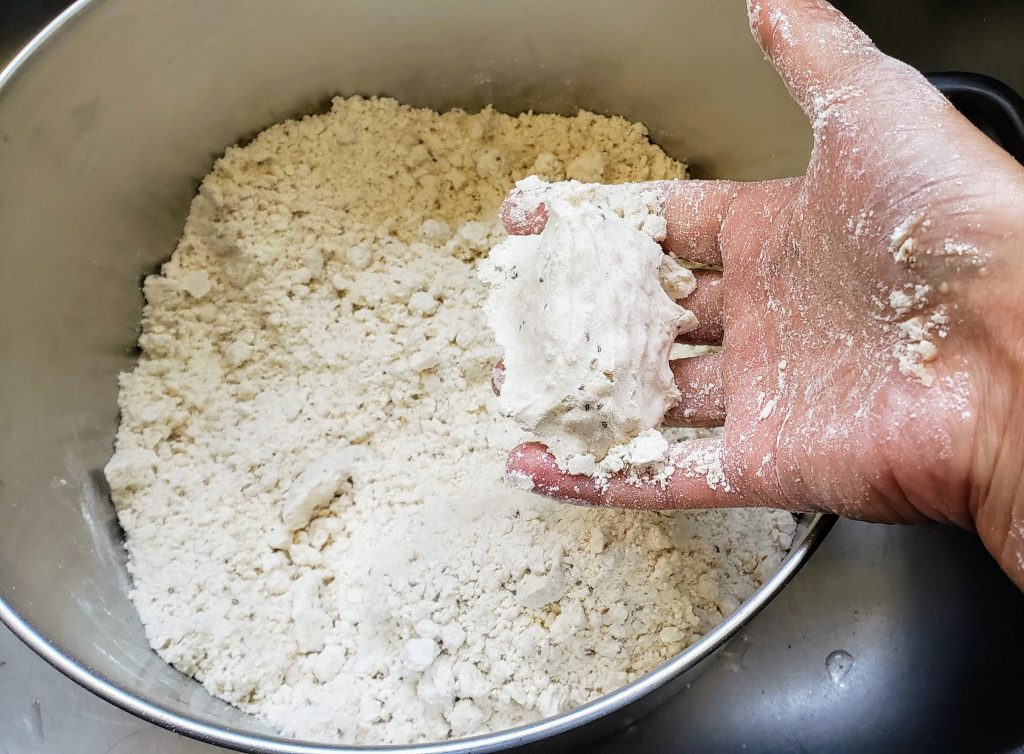
dough must hold the shape of your fist easily
3. Slowly add the chilled water. Mix well, until the flour just barely comes together to form a ball of dough. Gather up any dry flour in the bowl and pat it into the formed dough ball. If needed, add another tablespoon or so of water until there is no remaining dry flour.
4. Wrap the ball of dough in cling wrap and let it rest at room temperature for at least 30 minutes.
5. Once the dough has rested, break it up into 4 chunks and break up each chunk into 4 or 5 pieces about 1-inch in diameter and form them into balls.
6. Be sure to read the tips for deep frying and set up your equipment accordingly. Fill the vessel you are using for deep frying with either canola, peanut or sunflower oil to a depth of 2 1/2 inches.
7. Heat over medium-high until the temperature of the oil reaches 350F. I would suggest using a thermometer designed for deep-frying. Otherwise, break off a small piece of dough, drop it into the oil and see if it bubbles up to the surface.
8. Roll out the tiny balls of dough into a 2 1/2-3 inch disc. The discs should be about 1/8-inch thick.
9. Stack 3 discs and pierce them in several places using a dinner fork, flip the stack and repeat. This will prevent the discs from puffing up when they are being fried. It is the same reason you pierce pie dough and pizza dough before baking.
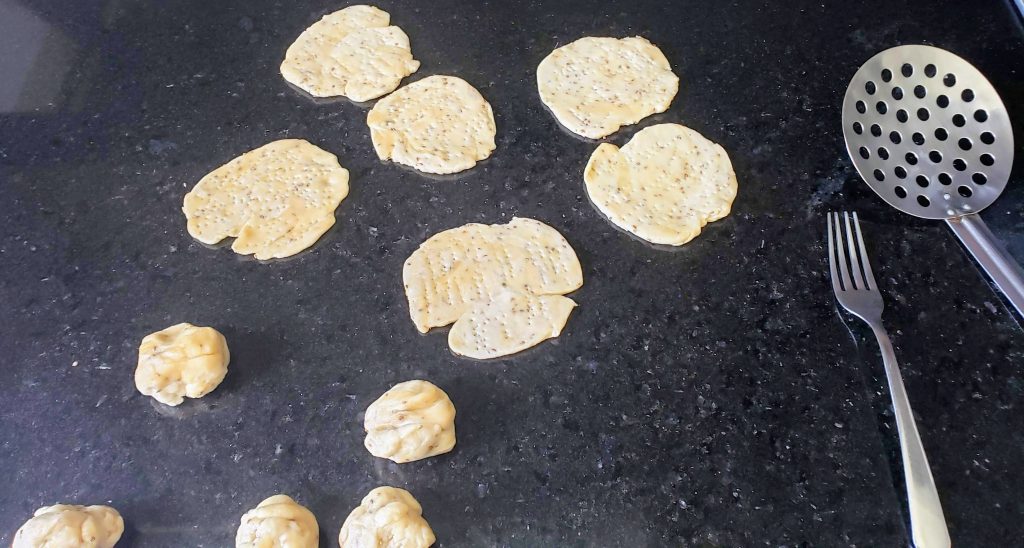
Roll out dough and pierce it with a fork
10. Fry the first batch of Mathis, a few at a time, for about 2 minutes. Turn them over and cook for another minute or two. Remove from the oil and place on a paper towel-lined tray. Mop up the surface of the Mathis to absorb any excess oil before it gets reabsorbed into the food. The Mathis will appear light in color.
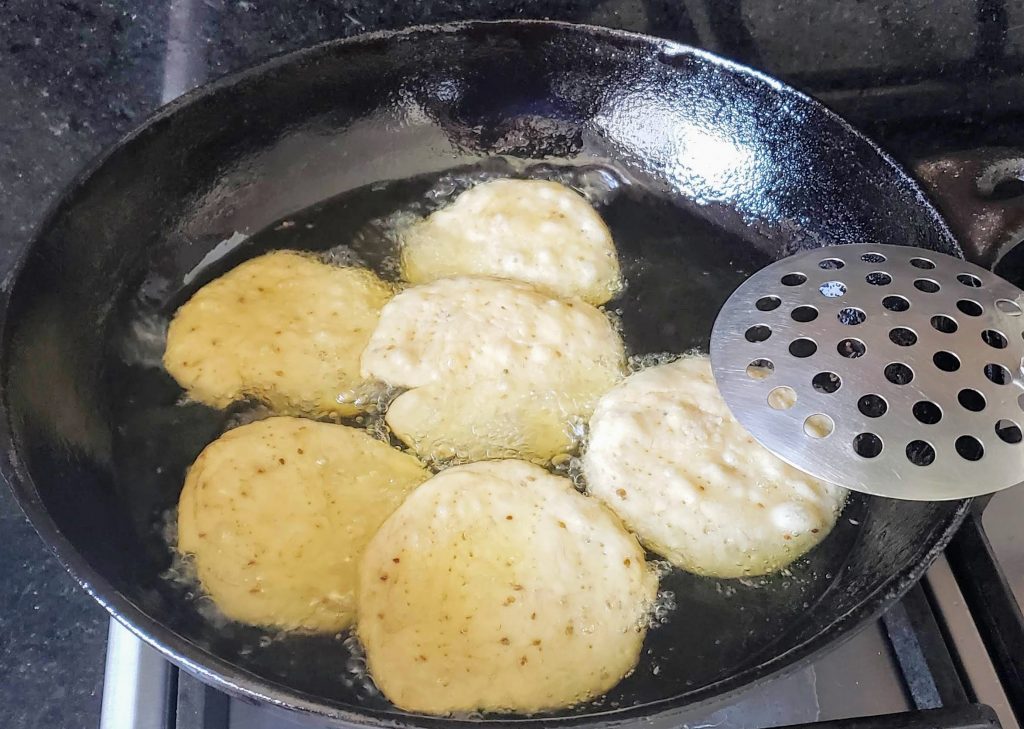
Initial frying
11. Repeat Steps 8-10 until the entire batch has been fried at 350F. Allow the oil to heat up to 375F and refry the Mathis until they turn golden brown. This will take between 1 to 2 minutes per batch. Drain on a paper towel-lined tray and gently mop up the surface with paper towels before serving.

Second Frying 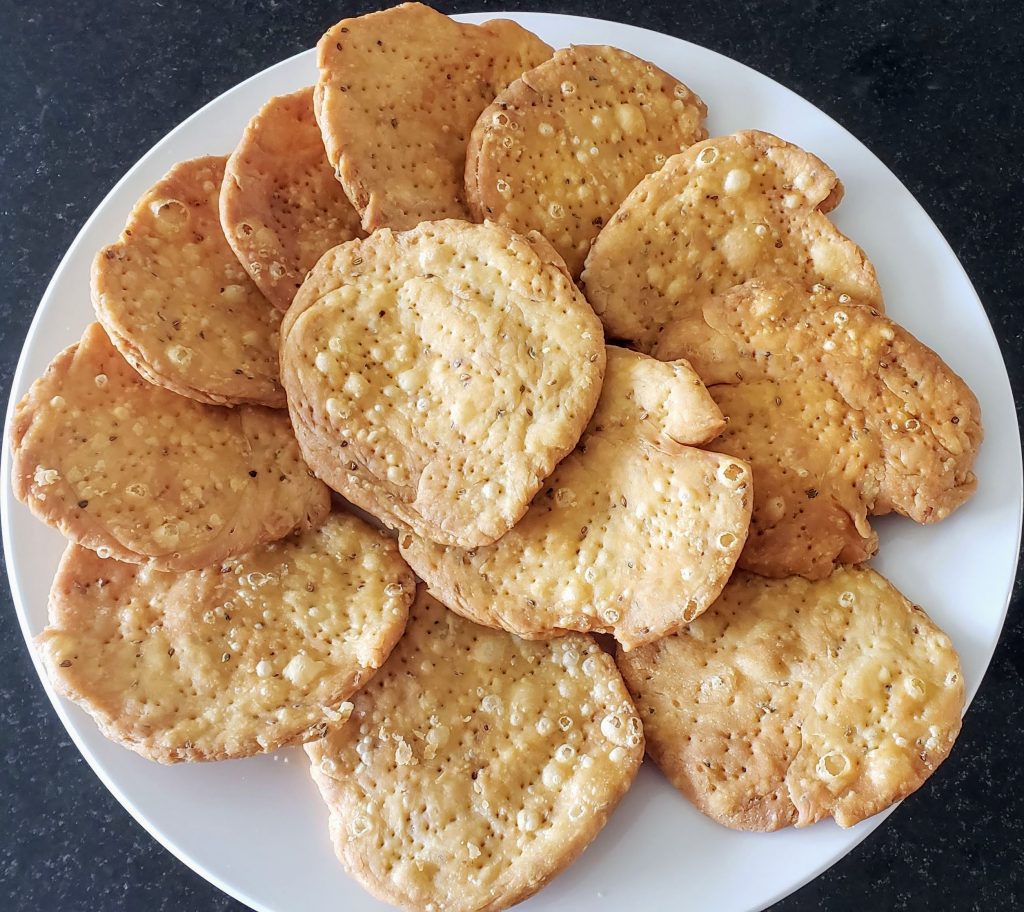
Golden brown and crispy
Note: *These ingredients may be purchased at your local Indian grocer. For this reason, I have given you the name of the spice both in English and Hindi as that is the name (written phonetically in the English alphabet) you will find it under when you go shopping.
Spices impart specific flavors and aromas that enhance the overall flavor of the dish when used correctly. Moreover, they have a lot of health benefits. The list below specifies:
- The name of the spice;
- The flavor(s) it imparts;
- How and when it may be used; and, finally,
- It’s health benefits.
Ajwain (carom seeds) – Astringent, sharp. Add last to season cooking oil as it is very strong and may turn bitter. It is used in making Kari (a stew made from gram flour) and added to lentil batters as it helps combat gas and bloating. Generally used in doughs or made into decoctions with a little salt for gas pain. Chew 1/2 a teaspoon of the seeds with 1/8 teaspoon of salt to get instant relief from acidity and/or gas pain. Good for indigestion and reducing gas. A decoction of the seeds is ingested with the addition of a little salt as a digestive aid. It is an anti-inflammatory. Carom is also an anti-oxidant and has anti-bacterial and anti-fungal properties. It is also high in iron.
Jeera/Geera (cumin seeds) – Earthy, smoky. The whole form is added as one of the first spices when seasoning cooking oil. If using it in the powdered form to season cooked food, add it after the burner has been turned off. Used whole when flavoring cooking oil in vegetarian and meat dishes. The whole form is added as one of the first spices when seasoning cooking oil. Used as a powder either by itself or as part of Garam Masala after cooking for both vegetarian and meat dishes. Whole seeds are boiled in water to make a tisane to aid digestion (reduces gas), for weight loss, and relaxation. Rich in iron – it has 66g of iron per 100g which is five times the daily dose. Aids in digestion; improves blood cholesterol; promotes weight loss and fat reduction; and, helps promote sleep. It also helps with diabetes. It has both stimulating and calming effects. Improves cognitive function and helps prevent cognitive disorders such as dementia and Alzheimers. It also improves lactation.
Kali Mirch (black pepper) – Sharp, spicy. Whole peppercorns can be added early on when using them to season cooking oil. However, the ground form is only used toward the end of cooking. Black pepper is used as a condiment and a food preservative. It is one of the components of Garam Masala and Chaat Masala. It is used whole to season doughs like Mathi (savory crip wafer). It is most often ground and used as a condiment in cooked foods. The ground form, when mixed with honey is used to relieve coughs and sore throats and improve breathing. Whole peppercorns are brewed into a tisane to effect the same benefits. For best results, don’t buy it preground as you’ll lose not only flavor but also many health benefits. BLACK PEPPER INCREASES THE BIOAVAILABILITY of certain other nutrients, especially, but not limited to CURCUMIN, WHICH IS THE ACTIVE INGREDIENT OF TURMERIC. It helps reduce swelling; is a known antibacterial; it’s an anti-inflammatory; and, is high in antioxidants. It is a natural pain killer. In ancient times, it was used in conjunction with salt to preserve meat. It helps drain the sinuses.
Sooki Methi (dried, crushed fenugreek leaves) – Earthy, bitter. Whole seeds are used to season oil but should be added late as they are bitter. Used to season food after turning the burner off. Used as a condiment for gravies after cooking either meats or vegetables. It is added as a seasoning for bread dough and Mathi dough. Fresh fenugreek makes a delicious vegetable dish when added to potatoes. It promotes lactation for breastfeeding mothers; it reduces the symptoms of menopause; reduces menstrual comfort; lowers cholesterol; controls diabetes; and, is an appetite suppressant. If you plant the seeds, you’ll get fresh fenugreek.
Written by Anju Kapur of Anju’s Table. All content and images on this site are copyright protected. Please do not use any of my images without my permission. Should you wish to share this recipe on your site, please add a link to this post as the source.
